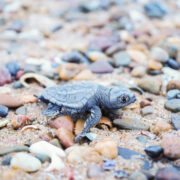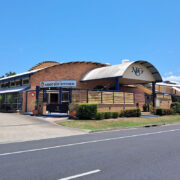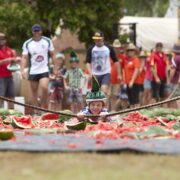Road Trip in Regional South East Queensland
Top 5 spots to visit on a road trip from Brisbane to Roma
Embark on an unforgettable road trip to Regional South East Queensland. Drive inland from Brisbane to Roma and explore the little towns and natural wonders along the way. This journey offers a perfect blend of history, culture, and outdoor adventures.
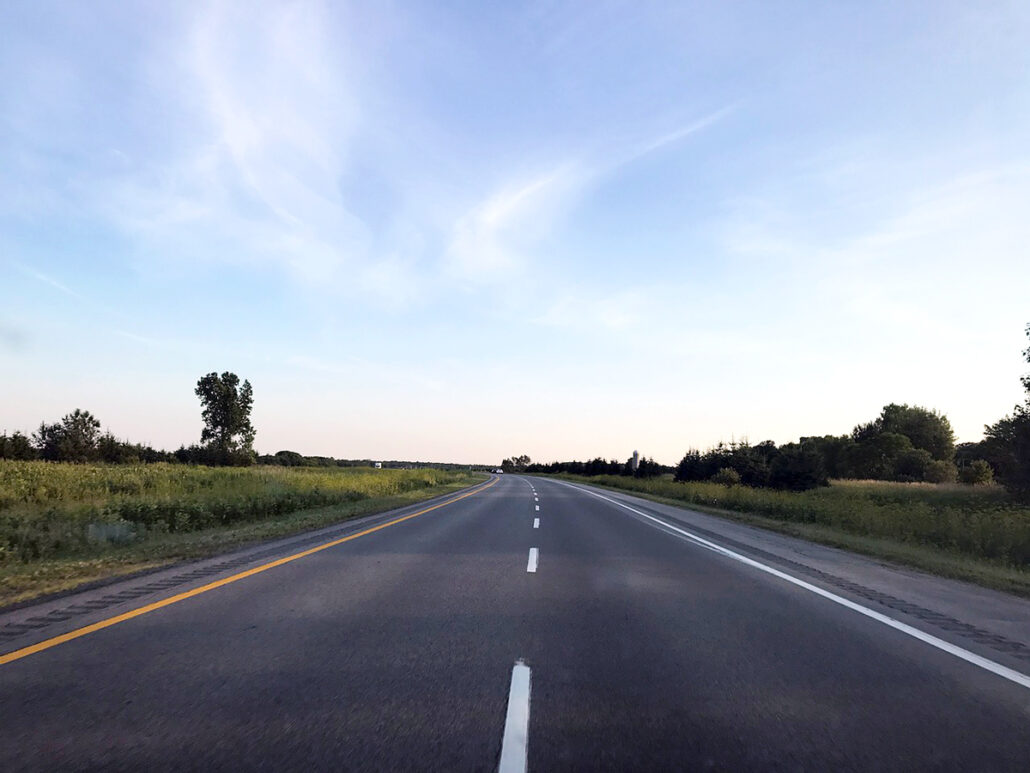
Here are the top 5 places you must visit during your road trip out to Regional South East Queensland.
1. Ipswich
Located in the heart of Regional South East Queensland, about a 40 minute drive from Brisbane, Ipswich offers a delightful blend of heritage and modern attractions, making it a must-visit destination for travellers. Queensland’s oldest provincial city offers a delightful mix of history, culture, and outdoor adventures.
Steeped in rich heritage, Ipswich boasts a variety of beautifully preserved buildings and landmarks that tell the story of its past. A stroll through the city centre reveals charming heritage-listed sites, such as the Old Ipswich Courthouse and the ornate St. Mary’s Catholic Church. The Ipswich Art Gallery, housed in a historic building, showcases an impressive collection of contemporary and traditional artworks, providing an enriching cultural experience for visitors of all ages. Steeped in history, Ipswich is home to beautifully preserved colonial architecture and heritage sites like the Workshops Rail Museum, showcasing the region’s rich industrial past.
For nature enthusiasts, Ipswich is a gateway to stunning natural reserves and scenic parks, where kids can explore dinosaur fossils or explore cultural sites. The Kholo Gardens serves as a picturesque spot for picnics and leisurely walks, complete with a historic well and a relocated old church. Denmark Hill Conservation Reserve offers breathtaking views of the city and features well-maintained walking trails through eucalypt forests, perfect for birdwatching and spotting local wildlife.
For a family-friendly outing, Colleges Crossing Picnic Area provides ample picnic facilities, playgrounds, and opportunities for water-based activities along the Brisbane River. For a dose of adrenaline, head to the renowned Willowbank Raceway for thrilling motorsport events. Whether you’re exploring Ipswich’s historic sites during your road trip or enjoying its natural beauty, Ipswich promises a rewarding and memorable visit for all travellers.
Must See Attractions:
The Workshops Rail Museum
Begin your adventure in Ipswich, a city with a rich railway heritage. The Workshops Rail Museum is a must-visit, offering an immersive experience into Queensland’s rail history. With interactive exhibits, heritage steam trains, and hands-on activities for kids, this museum is perfect for families and history enthusiasts. Don’t miss the chance to see the beautifully restored locomotives and carriages and learn about the pivotal role railways played in shaping Queensland.
Willowbank Raceway
Just outside of Ipswich is one of drag racing’s most famous tracks – Willowbank Raceway which offers a year-round program of high-octane drag racing entertainment. The raceway hosts numerous national and international competitions, including the Winternationals, which is the largest drag racing event outside of North America. With its state-of-the-art facilities and dedicated fan base, Willowbank Raceway offers an exhilarating experience for both spectators and participants, making it a must-visit destination for motorsport enthusiasts.
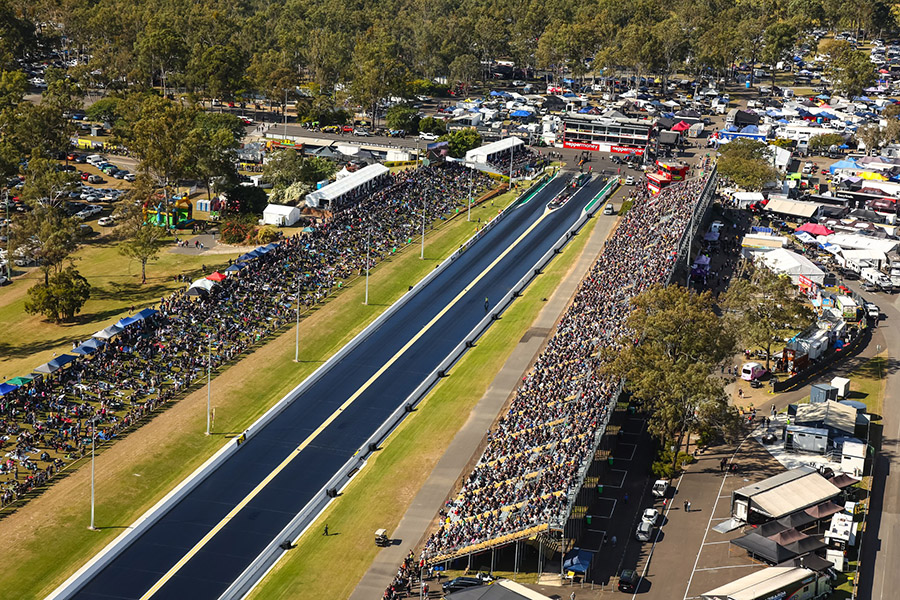
Image via Willowbank Raceway
Top Parks in Ipswich
Ipswich has an abundance of parks in the Regional South East Queensland area and is a great area for kids of all ages. Some of the more well-known parks in Ipswich and surrounding areas include:
Queens Park – While in Ipswich, take a leisurely stroll through Queens Park and Ipswich Nature Centre. This historic park, established in 1864, is one of the oldest in Queensland and boasts beautifully manicured gardens, a Japanese-style Nerima Gardens, and a nature centre where you can see native animals and birds. It’s an ideal spot for a picnic or simply to relax and enjoy the serene environment before continuing your journey.
Kholo Gardens – Kholo Gardens in Ipswich, once the site of a water pumping station, is now a picturesque venue known for its historical charm and natural beauty. The gardens feature a historic well, a relocated old church, and a beautifully restored Queenslander, making it a popular spot for weddings and functions. Visitors can also enjoy the barbecues, picnic tables, and public toilets, perfect for a relaxing day out amidst lush greenery.
Denmark Hill Conservation Reserve – Denmark Hill Conservation Reserve boasts a network of walking trails that wind through lush forests, providing breathtaking views and opportunities for wildlife spotting. The highlight is the water tower lookout, which offers panoramic views of Ipswich and beyond. The Triassic Circuit located in Denmark Hill is also a great spot for kids to discover dinosaur fossils and footprints. With its tranquil atmosphere and natural beauty, Denmark Hill Conservation Reserve is a perfect spot for hiking, picnicking, and reconnecting with nature.

Purga Nature Reserve – Purga Nature Reserve is renowned for its ancient remnant bushland, featuring one of the largest remaining stands of endangered Swamp Tea Tree forests. Visitors can enjoy peaceful walking trails, birdwatching, and the chance to spot native flora and fauna in their natural habitat.
Colleges Crossing – Located along the Brisbane River near Ipswich, Colleges Crossing is a popular spot for families and nature lovers. This picturesque area offers ample picnic facilities, including shaded tables, barbecues, and playgrounds, making it ideal for a road trip stopover. The serene river views and lush green surroundings provide a perfect backdrop for relaxation and recreation. Whether you’re kayaking, fishing, or simply enjoying a leisurely stroll along the riverbank, Colleges Crossing Picnic Area is a fantastic destination for outdoor activities.
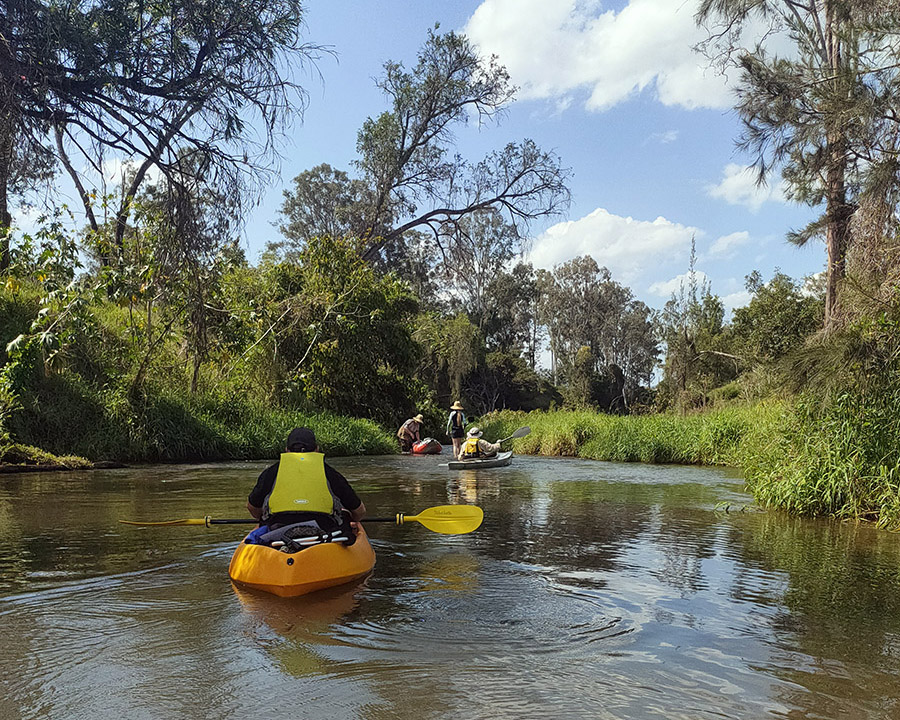
Bob Gamble Park – River Heart Parklands – A fantastic spot for the adults and kids. Overlooking the Bremer River this park features a large water play area as well as play equipment, flying fox and a football field sized “Discovery Forest” with forts, bridges and wooden totem poles. You can spend hours here letting the kids play while having a picnic on one of the BBQ’s in the area.
Cunninghams Knoll – Located opposite Queens Park you will find a large pyramid of limestone that pays homage to the region’s early European explorers and convict history. The pyramid was built in the 1930’s during the depression.
White Rock – Spring Mountain Conservation Estate
Located just out of Ipswich in Redbank Plains, this conservation park boasts over 2,500 hectares of bushland, offering a variety of trails for walking, hiking, mountain bike riding and horse riding. White Rock is a significant cultural site for the Indigenous Ugarapul people. Here you will find caves, outcrop overhangs, the impressive White Rock itself and spectacular views of the surrounding area.
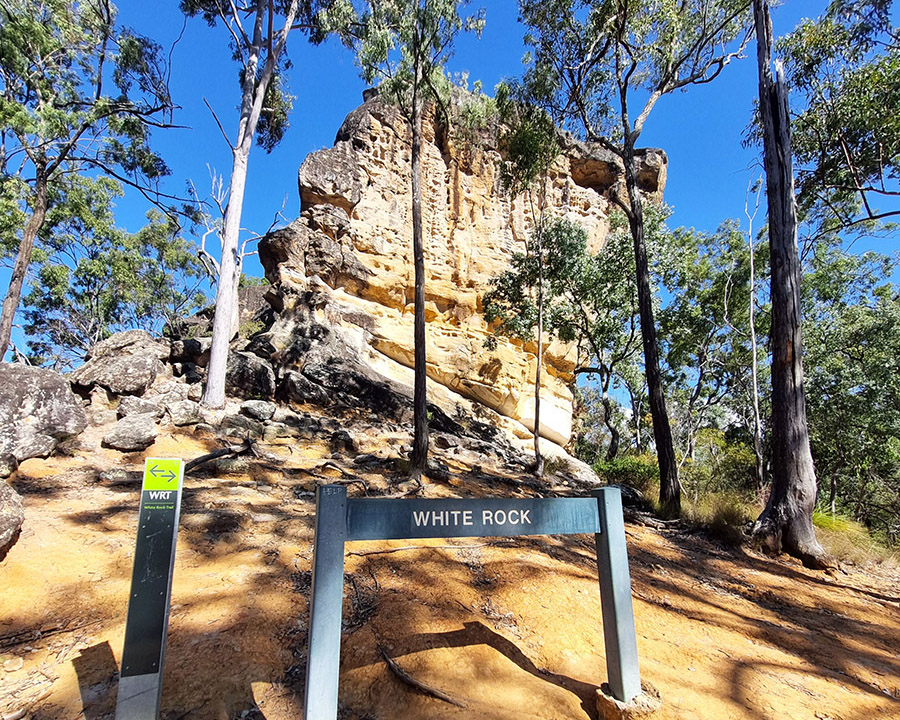
2. Toowoomba
Located in the Darling Downs, Toowoomba, often referred to as the “Garden City,” is a vibrant and scenic destination located atop the Great Dividing Range in Queensland. Known for its stunning parks and gardens, Toowoomba is particularly famous for the annual Carnival of Flowers, which transforms the city into a colourful spectacle of blooms and greenery.
Visitors can stroll through the meticulously maintained Queens Park and Botanic Gardens, or take a scenic drive to the breathtaking Picnic Point for panoramic views of the Lockyer Valley. The city’s blend of heritage architecture and modern amenities creates a welcoming atmosphere for both tourists and locals alike.
Beyond its natural beauty, Toowoomba boasts a rich cultural scene with a variety of galleries, museums, and theatres. The Cobb+Co Museum offers an engaging glimpse into the region’s history and heritage, while the Empire Theatre, an iconic art deco building, hosts a range of performances from local and international artists.
For those who enjoy shopping and dining, the city centre offers an array of boutiques, cafes, and restaurants that cater to diverse tastes. Whether you’re exploring the picturesque parks, delving into the cultural experiences, or simply enjoying the relaxed pace of life, Toowoomba provides a delightful escape and an opportunity to experience the best of Queensland’s largest inland city.
Must see attractions:
Toowoomba Carnival of Flowers
Visit Toowoomba during September to experience the Toowoomba Carnival of Flowers, Australia’s longest-running floral event. The city comes alive with vibrant flower displays, garden tours, live music, parades, and food and wine events. It’s a must-see festival that showcases the city’s horticultural heritage.
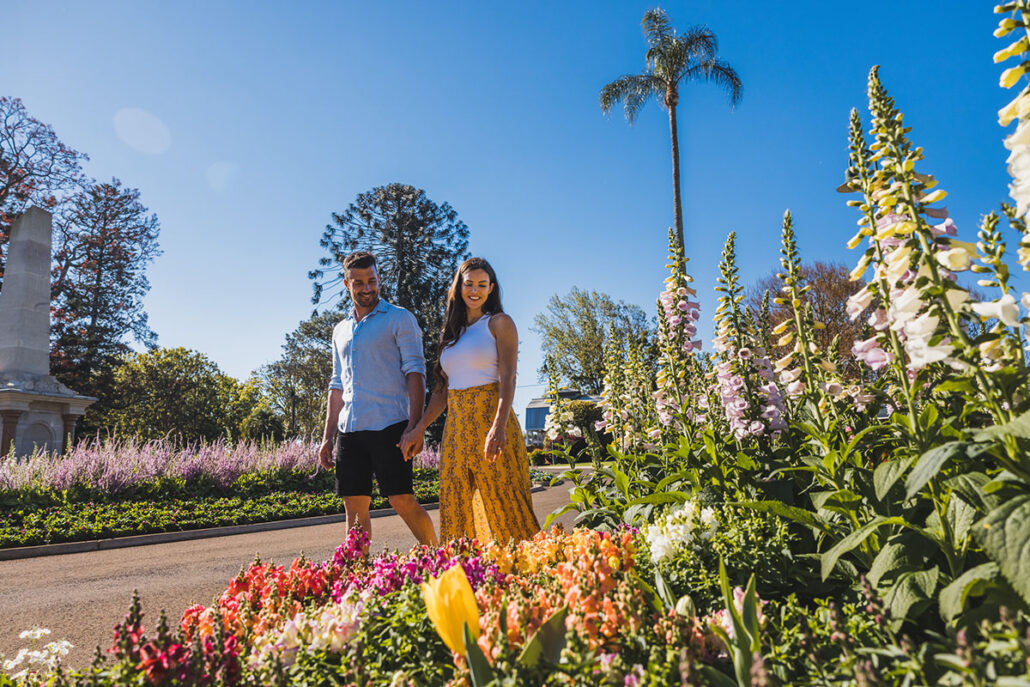
Image via Tourism & Events Queensland
Japanese Garden
The Japanese Garden, located within the University of Southern Queensland campus, is one of the largest and most traditionally designed Japanese stroll gardens in Australia. With its tranquil ponds, graceful bridges, and meticulously pruned plants, this garden provides a peaceful retreat. It’s a great place to unwind and appreciate the beauty of nature.
Table Top Mountain
Table Top Mountain is a striking flat-topped hill that dominates the Toowoomba landscape, providing adventurers with a rewarding hike and spectacular 360-degree views. The trail to the summit is a challenging yet exhilarating climb, offering glimpses of the unique flora and fauna along the way. Once at the top, hikers are greeted with sweeping views of the surrounding countryside, making the effort well worth it. Whether you’re an experienced hiker or just looking for a memorable outdoor adventure, Table Top Mountain is a must-visit landmark that showcases the rugged beauty of the region.
Picnic Point
Another highlight in Toowoomba is Picnic Point. This scenic lookout offers panoramic views of the Lockyer Valley and Tabletop Mountain. There are several walking tracks for those who want to explore the area further, including the Summit Walk, which provides breathtaking vistas. Picnic Point is the perfect spot for a family outing, a romantic picnic, or simply a peaceful retreat to soak in the natural beauty of Toowoomba. The on-site café is perfect for a quick snack or a refreshing drink while you soak in the stunning views.
Cobb & Co Museum
Delve into Toowoomba’s rich history at the Cobb & Co Museum, which features an impressive collection of over 50 horse-drawn vehicles, interactive exhibits, and hands-on workshops. The museum also hosts various events and activities that provide insight into the region’s heritage and culture. The museum also offers a range of workshops and demonstrations such as blacksmithing and heritage trades like leatherwork and woodwork, as well as hosting regular events and programs that cater to school programs and families.
3. Bunya Mountains National Park
As you continue your inland road trip through Regional South East Queensland, make sure to visit the Bunya Mountains National Park. Located in the Great Dividing Range, this unique park is home to the world’s largest stand of ancient bunya pines, which tower majestically over the lush rainforest and grasslands. A must-visit for nature lovers and outdoor enthusiasts, the park offers a plethora of activities to engage in. Hiking is one of the most popular pursuits, with several trails catering to different skill levels. There are numerous walking tracks ranging from easy strolls to challenging hikes.
Beyond hiking, the Bunya Mountains offer opportunities for wildlife spotting with wallabies, pademelons, and a myriad of bird species commonly seen. The area is also great for picnicking, with well-maintained facilities and scenic spots that invite relaxation. For those who wish to extend their stay, there are various accommodation options ranging from cozy cabins to camping sites. Whether you’re there to explore the trails, immerse yourself in the serene environment, or simply unwind in nature, Bunya Mountains National Park promises an unforgettable experience.
Must see attractions:
Scenic Circuit Loop Walk
One of the highlights is the Scenic Circuit, a 4 km loop walk through lush rainforest, past waterfalls and along creeks. The sounds of flowing water add to the serene ambiance of the walk. Depending on the season, these water features can range from gentle trickles to more impressive cascades.
This circuit allows you to enjoy panoramic views from various lookouts, marvel at the impressive bunya pines and spot native wildlife like wallabies and lizards as well as a variety of bird species. Keep an eye out for various plant species, including ferns, vines, and mosses that thrive in the moist environment. Wildlife sightings in this area are very common, with opportunities to spot native birds, such as the colourful king parrots and crimson rosellas, as well as wallabies and other small mammals.
Along the trail, interpretive signs provide interesting information about the natural and cultural history of the area, offering insights into the significance of the bunya pines, the indigenous heritage, and the unique ecosystems within the park. The park’s picnic areas are perfect for a lunch break amid nature.
The walk starts from the Dandabah picnic area, which is easily accessible and has parking facilities. The loop takes approximately 1.5 to 2 hours to complete, depending on your pace and the number of stops you make along the way.
Westcott to Cherry Plains Lookout Trail
For those seeking a longer trek, the Westcott to Cherry Plains Lookout trail provides a more challenging 6.4 km hike that rewards hikers with breathtaking views of the surrounding valleys and plains. The Cherry Plains Lookout is the highlight of the trail, offering panoramic views of the surrounding plains and valleys. On a clear day, you can see for miles, taking in the vast expanse of natural beauty that defines the Bunya Mountains region.
The trail traverses various landscapes, including dense rainforests, open eucalypt woodlands, and grassy plains. Along the trail, you’ll encounter a wide range of plant species, from towering bunya pines to delicate wildflowers. The area is also home to an array of wildlife, including wallabies, birds, and reptiles. Birdwatchers will especially enjoy the chance to spot species such as the crimson rosella and the regent bowerbird.
Compared to some of the more popular trails in the Bunya Mountains, the Westcott to Cherry Plains Lookout Trail offers a more secluded and tranquil hiking experience. It’s a great choice for those looking to escape the crowds and enjoy some peaceful time in nature.
The hike begins at the Westcott picnic area, which provides parking and basic facilities such as picnic tables and restrooms. The trail typically takes about 2 to 3 hours to complete, depending on your pace and how long you spend at the lookout. The trail is considered moderate in difficulty. It features some gradual inclines and uneven terrain, so a reasonable level of fitness is required.
Barker Creek Circuit
Another notable trail is the Barker Creek Circuit, an 11-kilometer path that winds through rainforest and open forest, passing waterfalls and creeks that are perfect for a refreshing dip. The circuit includes stops at several stunning waterfalls, including the Barker Creek Falls and the Paradise Falls, which is a serene spot with a small waterfall and a lovely pool. The trail takes you through lush subtropical rainforests and towering eucalypt forests. The Barker Creek Lookout offers sweeping views of the surrounding forests and valleys, providing a stunning panorama that is well worth the hike. Along the Barker Creek Circuit, you may encounter wallabies, echidnas, and a multitude of bird species, including the vibrant king parrot and the elusive satin bowerbird.
The circuit can be started from several points, including the Paradise Car Park and the Dandabah picnic area. Both locations offer parking and basic facilities. The Barker Creek Circuit typically takes around 3 to 4 hours to complete, depending on your pace and the number of stops you make along the way. The trail is of moderate difficulty, with some sections involving steep climbs and uneven terrain. A reasonable level of fitness is required to complete the circuit comfortably.
Mount Kiangarow
For more adventurous travellers, the hike to Mount Kiangarow is a must. The cooler climate and fresh mountain air make this a refreshing stop on your road trip through regional Queensland. Mount Kiangarow is the highest point in the Bunya Mountains at 1,135 meters above sea level. The walk to the top is a relatively easy and accessible hike, making it a popular choice for visitors of all ages and fitness levels.
The Mount Kiangarow Summit Walk is a 2.3 km return walk that begins from the Paradise car park and takes you through diverse vegetation and offers spectacular views from the summit. The track is well-maintained and features a gentle gradient, making it suitable for most hikers. As you make your way to the summit, you’ll traverse through lush rainforest, open eucalypt forests, and patches of bunya pines, providing a diverse and engaging walking experience. Interpretive signs along the trail offer insights into the local flora and fauna, enhancing your appreciation of the natural environment.
Upon reaching the summit, hikers are rewarded with panoramic views of the surrounding landscape. On clear days, you can see as far as the distant plains and valleys, with the rich tapestry of forests and grasslands stretching out below. The summit of Mount Kiangarow is a fantastic spot for photography, birdwatching, or simply soaking in the serene atmosphere and the fresh mountain air.
In addition to its natural beauty, Mount Kiangarow holds cultural significance for the Indigenous people of the area. The Bunya Mountains were a traditional meeting place for Aboriginal groups, who gathered here to feast on the abundant bunya nuts and participate in ceremonies and social events. Walking the trails and reaching the summit of Mount Kiangarow provides a connection to this rich cultural heritage, adding depth and meaning to your visit.
4. Chinchilla
Located in the Western Downs region of Queensland, Chinchilla is known for its friendly atmosphere, unique attractions, and agricultural significance. Often referred to as the “Melon Capital of Australia,” Chinchilla is famous for its biennial Melon Festival, which draws thousands of visitors for a weekend of quirky competitions, delicious food, and family-friendly fun.
Apart from its melon fame, Chinchilla boasts a rich history and natural beauty. The town’s Historical Museum offers a glimpse into the past with its well-preserved artifacts, heritage buildings, and informative displays. Visitors can learn about the area’s pioneering days, agricultural development, and the importance of the railway to Chinchilla’s growth.
For nature enthusiasts, the Chinchilla Weir provides a tranquil setting for fishing, boating, and picnicking. Additionally, the nearby Barakula State Forest, the largest state forest in the Southern Hemisphere, offers opportunities for bushwalking, camping, and exploring diverse flora and fauna.
Chinchilla also serves as a gateway to the Western Downs’ broader attractions. Its central location makes it an ideal base for exploring nearby towns and natural wonders along your road trip. With its unique blend of cultural events, historical significance, and natural beauty, Chinchilla offers a delightful and enriching experience for all who visit.
Must see attractions:
The Chinchilla Melon Festival
The Chinchilla Melon Festival is a quirky and vibrant event held biennially and celebrates Chinchilla’s status as the “Melon Capital of Australia”, which honours the town’s significant contribution to the melon industry. The festival began in 1994 and has grown into a major event, attracting thousands of visitors from across the country and even internationally. The Melon festival features events like melon skiing, melon bungee, and the melon chariot race, making it a must-visit for anyone looking for a fun and memorable experience.
The Melon Festival is designed to be family-friendly, with activities and games for children, such as face painting, melon rolling, and arts and crafts. The festival fosters a strong sense of community, with local businesses, residents, and volunteers coming together to make the event a success. It’s a time for Chinchilla to showcase its hospitality and pride.
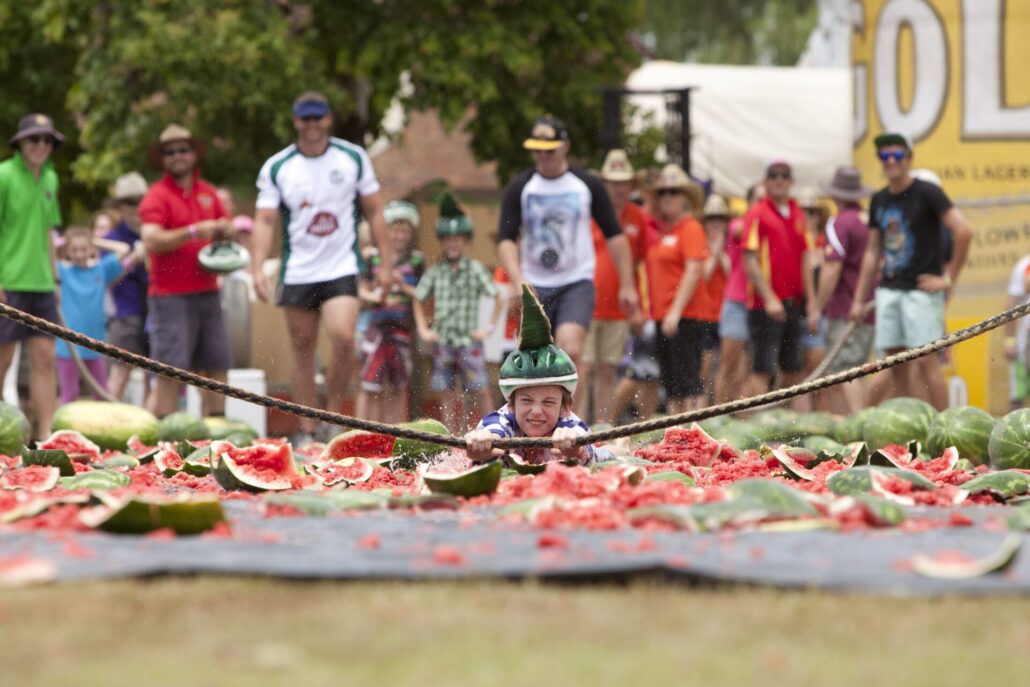
Image via SQCT
Key Highlights of the Melon Festival:
Melon Skiing – One of the most iconic and popular events, melon skiing involves participants strapping their feet onto watermelons and attempting to ski across a soapy tarpaulin. It’s a fun and slippery challenge that guarantees plenty of laughs and excitement.
Melon Bungee – In this hilarious event, participants are harnessed to a bungee cord and race to collect as many melons as possible before being yanked back. It’s a test of strength, speed, and strategy.
Melon Chariot Race – Teams build chariots using melons and race them through an obstacle course. Creativity and teamwork are key to winning this entertaining race.
Melon Toss and Melon Dash – For the melon toss, participants throw watermelons for distance, and the melon dash is a race that tests agility and speed.
Melon Ironman and Ironwoman Competitions – These events combine several melon-related challenges, including melon skiing, carrying, and eating. Competitors must display endurance, strength, and a hearty appetite to win.
Melon Eating Competition – Participants race to consume as much watermelon as possible within a set time limit. It’s a messy but delicious challenge that draws enthusiastic crowds.
Melon Bungy and Melon Bullseye – Melon bungy is where participants launch watermelons into the air, and melon bullseye, aiming for targets with melon projectiles.
Parade and Entertainment – The festival includes a vibrant parade featuring floats, music, and performers. There are also live music performances, food stalls, and various entertainment options for all ages.
The Big Melon
No visit to Chinchilla is complete without seeing the Big Melon, which is just on the outskirts of the town. This quirky roadside attraction celebrates Chinchilla’s reputation as the “Melon Capital of Australia” and is a great spot for a fun photo op with one of the “Big Things” of Australia.
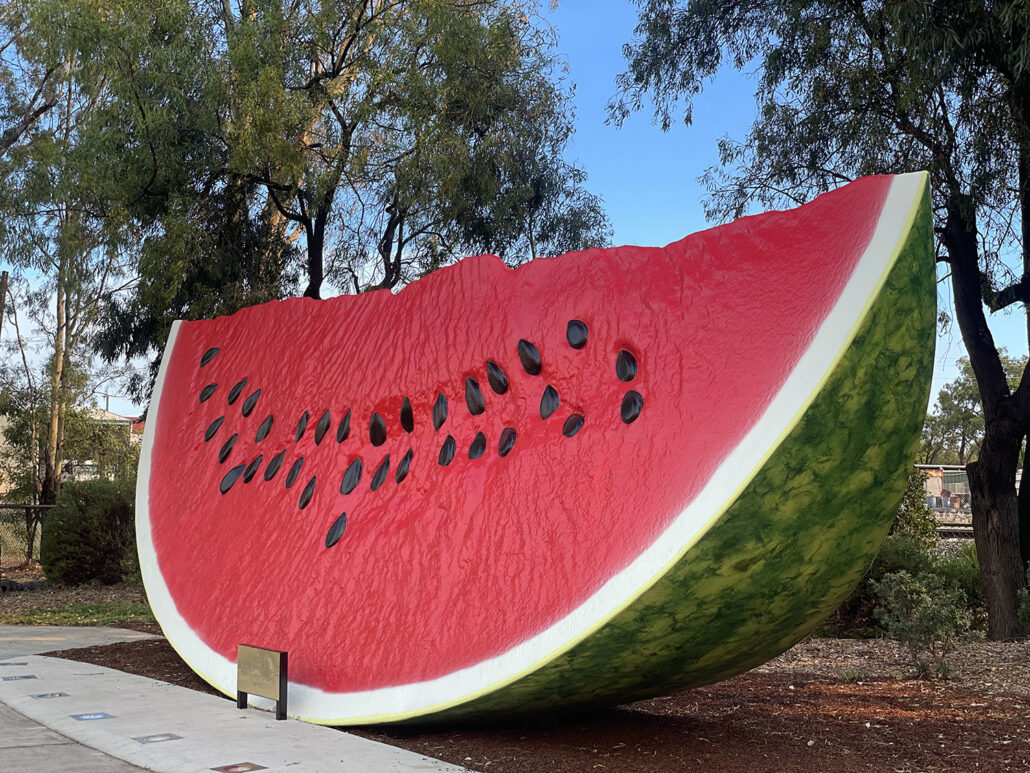
Chinchilla Weir
The Chinchilla Weir is a popular spot perfect for a relaxing afternoon by the water. You can enjoy activities like fishing, kayaking, or simply have a picnic by the banks of the Condamine River. There is a kids playground overlooking the water as well as a camping area for those who are travelling with a caravan. There are picnic tables and shelters available which make it an idea spot for a picnic. The weir is a popular spot for birdwatching, with various species inhabiting the area. The weir is also known for its beautiful sunsets, so take your camera and plan your visit accordingly to witness a breathtaking end to the day.
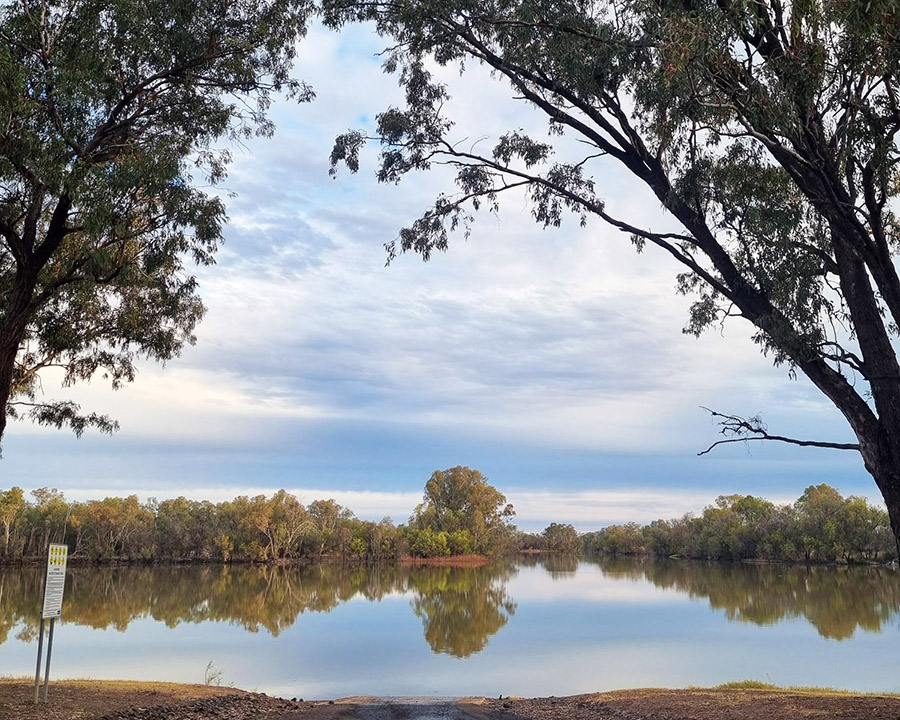
Barakula State Forest
Barakula State Forest is the largest managed state forest in the Southern Hemisphere, which is renowned for its spectacular wildflowers from late winter to spring. It’s a working forest which supplies most of Queensland’s cypress pine timber to the area. Barakula is also a great place for a self-drive tour with highlights including the dingo barrier fence, Charley’s Creek, Wongongerra Creek and “Speculation”, the site of Australia’s first oil bore.
5. Roma
Situated in the Maranoa region of outback Queensland, Roma offers visitors a blend of cultural heritage, outdoor adventure, and a relaxed country atmosphere.
One of the notable attractions in Roma is the Big Rig, a museum and interpretive centre dedicated to the history of Australia’s oil and gas industry. Here, visitors can learn about the pioneering spirit of the early drillers and see exhibits showcasing the machinery and technology used in the industry. For those interested in history, Roma also boasts the Roma Saleyards, one of the largest cattle selling centres in Australia. This iconic site offers guided tours where visitors can learn about the livestock industry that has been pivotal to the region’s economy for over a century.
Nature enthusiasts will find plenty to explore in and around Roma. The nearby Carnarvon Gorge and the Mount Moffatt sections of Carnarvon National Park are within driving distance, offering stunning landscapes, ancient Aboriginal rock art, and diverse flora and fauna.
Roma’s vibrant community hosts various events throughout the year, including the Roma Easter in the Country Festival and the Roma Cup, attracting visitors from near and far. With its friendly locals, historical landmarks, and natural wonders, Roma offers a quintessential Australian outback experience.
Must see attractions:
The Big Rig
Arriving in Roma, the Big Rig is a must-visit attraction. This informative museum offers insights into the history of Australia’s oil and gas industry. The Night Show at the Big Rig tells the story of Roma’s oil boom through an engaging sound and light display. During the day, explore the various exhibits, including a working oil rig and historical machinery. It’s an educational experience that sheds light on an important aspect of the region’s history.
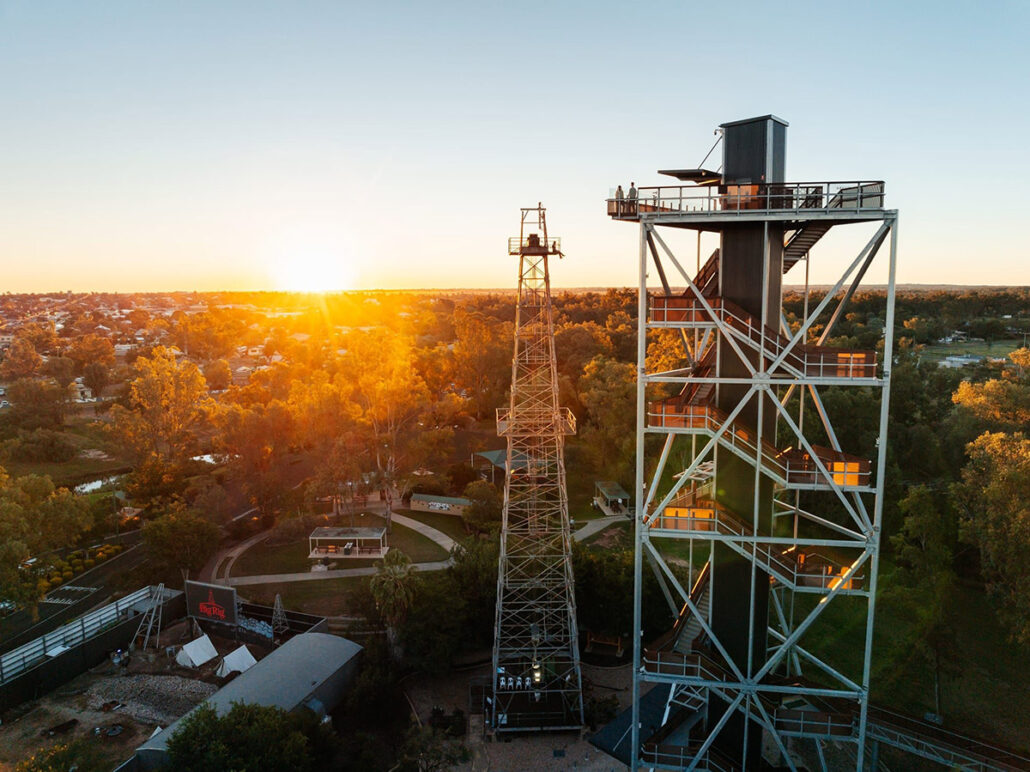
Image via Tourism & Events Queensland
Roma Saleyards
The Roma Saleyards is the largest cattle-selling centre in the Southern Hemisphere. Join a guided tour to learn about the livestock industry and see the action up close. If you’re lucky, your visit might coincide with a live auction, providing a unique and authentic Outback experience. The saleyards are a testament to Roma’s significant role in Australia’s agricultural landscape.
Carnarvon Gorge
Carnarvon Gorge, located within Carnarvon National Park in Queensland, is renowned for its breathtaking landscapes, ancient Aboriginal rock art, and diverse wildlife. It is one of Queensland’s most iconic natural attractions, drawing visitors seeking both adventure and tranquillity.
The gorge features towering sandstone cliffs that rise to 200m high, creating a dramatic backdrop for hiking and exploration. Visitors can embark on several walking trails that lead through lush, subtropical rainforest, past crystal-clear streams, and into narrow gorges adorned with ferns and moss-covered walls.
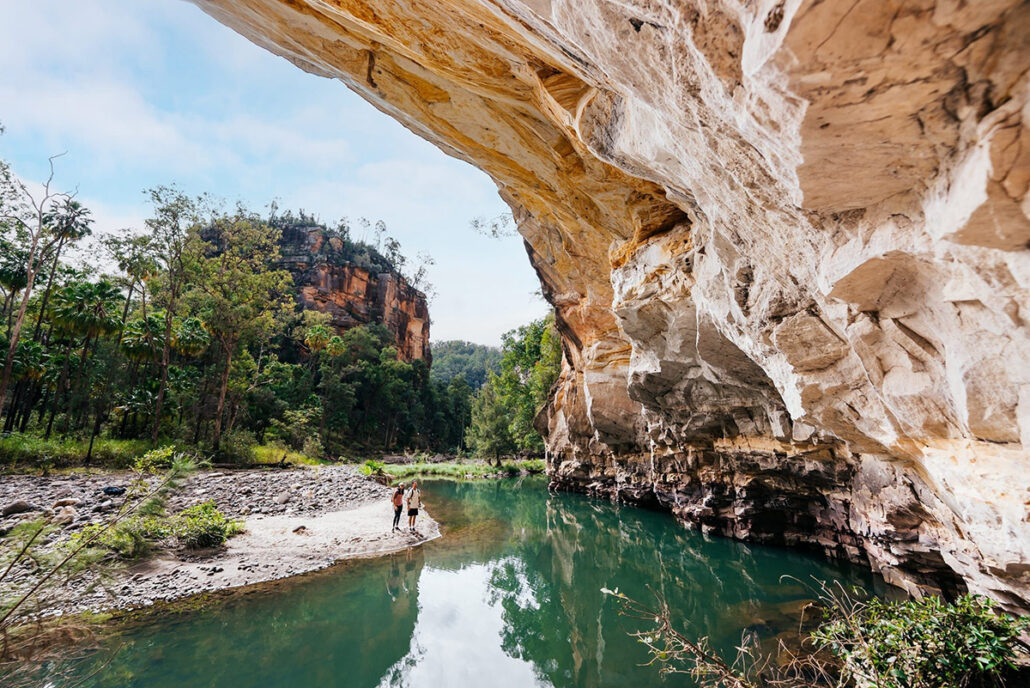
Image via Tourism & Events Queensland
Carnarvon Gorge is home to numerous Aboriginal rock art sites, showcasing stencil art and engravings that date back thousands of years. These artworks provide a glimpse into the cultural history and spiritual significance of the traditional owners of the land, the Bidjara and Karingbal Aboriginal people.
If you are looking for the best spots to hike in the area, the Amphitheatre is a natural rock formation with towering walls that create exceptional acoustics and is a must-see attraction. The Moss Garden is a serene oasis where delicate ferns and mosses thrive in the cool, moist environment created by perennial springs. Another challenging hike to Boolimba Bluff rewards hikers with panoramic views across the gorge and surrounding landscapes. The lookout at the end offers a stunning vantage point to appreciate the scale and beauty of Carnarvon Gorge.
A road trip from Brisbane to Roma offers a diverse and enriching experience, with each stop presenting unique attractions and natural wonders. Whether you’re exploring historic sites in Ipswich, enjoying the gardens of Toowoomba, hiking in the Bunya Mountains or Carnarvon Gorge, or delving into Roma’s rich agricultural history, this journey is sure to create lasting memories. Be sure to plan your route carefully, allowing enough time to fully enjoy each destination. And remember, the journey is just as important as the destination, so take your time and savour the beauty and charm of that regional Queensland has to offer travellers.


